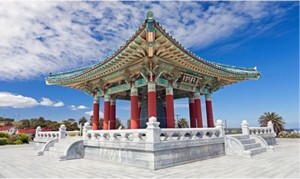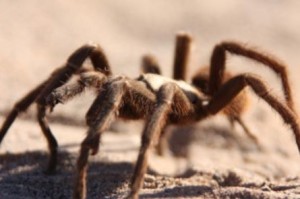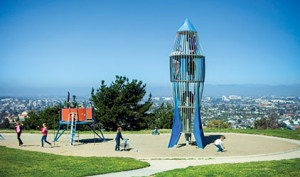These old-school playground help imaginations soar
Remember carefree days outdoors as a youth, spinning until dizzy on a merry-go-round or rubbing waxed paper on a metal slide for a zippier ride? Public playgrounds have long held a special sway, delighting children and filling the rest of us with nostalgia.
With their roots in 19th-century Germany, playgrounds encourage exercise, good manners, and healthy competition. In 1837, German education specialist Friedrich Fröbel founded the precursor to the modern kindergarten and paved the way for children to connect with the outdoors through play.
The trend arrived stateside at a time when immigrant families were crowding into urban neighborhoods. Social reformers advocated playgrounds as a way to curtail delinquency and provide a safe place for children to play. The first American playground was built at San Francisco’s Golden Gate Park in 1887.
Early playground equipment resembled gymnasium apparatuses that were meant to appeal to kids of all ages. However, artists and architects in the post–World War II period brought a new aesthetic to play structures. Spurred by a growing movement of experimentation in the 1950s and ’60s, they saw playgrounds as untapped territory for expression using unusual forms, materials, and themes, says Paige Johnson, who blogs about playground design at Play-scapes.com.
Many playgrounds from that era have disappeared and been replaced with prepackaged plastic modules. But remnants of these fantastical worlds still can be found in Southern California. Here, on any given afternoon among whimsically formed concrete, steel, and wood, imaginations take off and lifelong memories are made.
Torrance Los Arboles “Rocketship” Park
- Best for ages 5-12
- Playtime: Plenty of lawn space for blankets; be mindful of little ones near the unfenced slope. No restrooms, few picnic tables, and street parking only.
In the 1960s, following the launch of the Soviet Sputnik satellite, rocket ships were blasting off at playgrounds all over the United States. These classic conical metal structures whizzed children into the vastness of outer space from the comfort of their neighborhood park.
Today, most metal ships have gone the way of the scrap yard, but some, including the Rocketship at Los Arboles Park, have found a permanent launch pad.
Installed in 1964 and then restored in 1992 (residents complained loudly when park officials removed the structure earlier that year), this four-level spaceship provides one of the best views of the entire L.A. basin and now features an official plaque from the Torrance Historical Society.
You’ll lose count how many times you hear “4, 3, 2, 1, blast off!” as astronauts in training scale a ladder inside the ship from bottom to nose top. The metal slide is long, fast, and best for older kids. Nearby, a metal replica of a lunar module, with firefighter poles, ladders, and controls, is ready for battling aliens and saving planet Earth. 5101 Calle de Ricardo, Torrance. 1-310-618-2930.
San Gabriel La Laguna de San Gabriel at Vincent Lugo Park
- Best for ages 1-12
- Playtime: Bike paths, with bridges over a dry creek bed, surround the playground. Restrooms, picnic areas, soda/water machines, and bike racks. Park in the east lot for closest access.
Slide through a snail’s mouth, climb sea serpent spires, and cavort with wild dolphins at La Laguna de San Gabriel, which has been inspiring children to play since 1965.
Located in a hidden corner of Vincent Lugo Park, this aquatic-themed fantasyland was handcrafted by then-72-year-old Mexican concrete artist Benjamin Dominguez (see sidebar).
Despite its charms, La Laguna was slated for demolition in 2006. Local residents rallied to save the park, and in 2009 the California Register of Historical Resources welcomed the entire menagerie.
Today, the city, along with the Friends of La Laguna, is working to preserve the landmark. Visitors will find repaired structures (the dock, Lookout Mountain slide), as well as pieces awaiting renovation, including the currently off-limits Ollie the Octopus. Bring sand toys for toddlers, and expect older kids to invent story lines about a treasure chest, a sunken pirate ship, seal-shaped islands, and a whale. 300 W. Wells Street, San Gabriel. 1-626-308-2875.


Garden Grove Atlantis Play Center
- Best for ages 1-13
- Playtime: The cash-only snack bar and water play area are open June–September. Restrooms and shaded picnic areas. Operating hours vary. $2 (cash only) for ages 3 years and older, free for ages 2 and younger.
Celebrating its 50th anniversary this June, the Atlantis Play Center is a fully enclosed oasis of imagination that’s filled with oversize concrete sea critters and bucolic rolling greenery.
Let the kids loose in this 4-acre play preserve to discover what lives around the corner, up the hill, or under the bridge. The park is often crowded in summer with children from camps, so weekends are better times to visit.
Concrete artist Dominguez fashioned many of his signature aquatic creatures here—sea serpents; dolphins; a shark; and the all-time favorite, a sea dragon shaped into a slide that gently swirls riders down from atop a high peak.
While young children endlessly race up sloped stairways and grassy hills, older kids can enjoy extreme hide-and-seek in the shrubbery. Walkie-talkies would be perfect for spy games, but leave bikes, scooters, and roller skates at home. These items, along with dogs, are not allowed in the park. 13630 Atlantis Way, Garden Grove. 1-714-892-6015.
West Covina Sabre Jet Fighter at Palm View Park
- Best for ages 3-10
- Playtime: Two play areas (one enclosed for toddlers) and some exercise equipment for teens and adults are nearby. Restrooms, a shaded picnic area, and soda/water machines.
This playground’s star attraction is a U.S. Air Force F-86D Sabre Jet. Plopped on its belly atop wood chips, the sleek, shiny silver aircraft is the real deal: The plane never saw active combat, but it was flown by the Air National Guard and at various military bases in the 1950s.
The West Covina Junior Jaycees and representatives of aerospace manufacturer North American Aviation worked to transport the flying machine to its current home in 1961. Since then, it’s been covered with plaster so little hands and knees won’t burn on the hot metal. Nearby water misters provide relief on hot summer days when kids have missions to fly.
Enter the plane from the tail via a makeshift rebar ladder and walk across the top to the cockpit for make-believe aerial encounters. Be sure to photograph your pilot in the red front nose. 1340 E. Puente Avenue, West Covina. 1-626-939-8430.
Benjamin Dominguez Trained in “trabajo rustic” (making concrete to look like wood) at the Escuela Nacional de Artes Plásticas (National Academy of Visual Arts) in Mexico City, Benjamin Dominguez achieved fame at the city’s Chapultepec Zoo with his elaborate cement lion and tiger caves.
After immigrating to the United States in the 1950s, Dominguez created concrete items for golf courses and open spaces (bridges, tree sculptures, etc.), but he quickly became known for his fantastical concrete playlands throughout the Western U.S. Sadly, many of his rebar-and-cement structures have been demolished. Today, Dominguez’s fanciful creations are found locally only in Garden Grove, San Gabriel, Coldwater Park in Beverly Hills, and Legg Lake Park in Whittier Narrows.
As a child, Eagle Rock freelance writer Brenda Rees was always hopeful to swing so high that she’d touch the sky.




